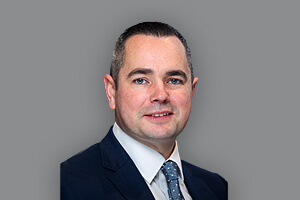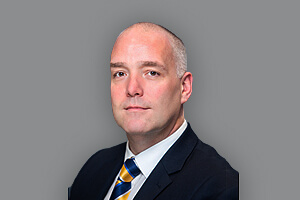Commercial cleaning and hygiene
You need excellence in commercial cleaning, and with almost four decades of experience with a vast range of customers, from corporate to hospital environments, we’ll help achieve it. Thanks to eco-friendly products, highly-trained professionals and innovative technology, our commercial cleaning contracts ensure you’ll enjoy the assurance your organisation’s environments are hygienic, safe and sanitised.
- Be inspired
- Our services
- Case studies
- Get in touch
We are the largest cleaning provider in the UK: Be inspired
- Insight
- 12 December 2024
- Case study
- 28 November 2024
- News
- 13 November 2024
Commercial cleaning: How we can help
From daily office cleans to immediate biohazard removal, or anything in between, our unique Science of Service® approach provides your organisation with innovative cleaning and hygiene solutions to run more efficiently. We deliver services to organisations of all sizes, in sectors from corporate to kitchens, in every corner of the country.
Optimise cleaning efficiency with the latest technologies
Did you know you can help your colleagues work smarter, implement demand-led cleaning and even save hundreds of hours a year? With our unique Merlin Connect intelligence platform, sensor arrays and data-driven activity, you’ll benefit from greater efficiency in your corporate cleaning programme.
Learn more about the latest Cleaning and Hygiene technology.
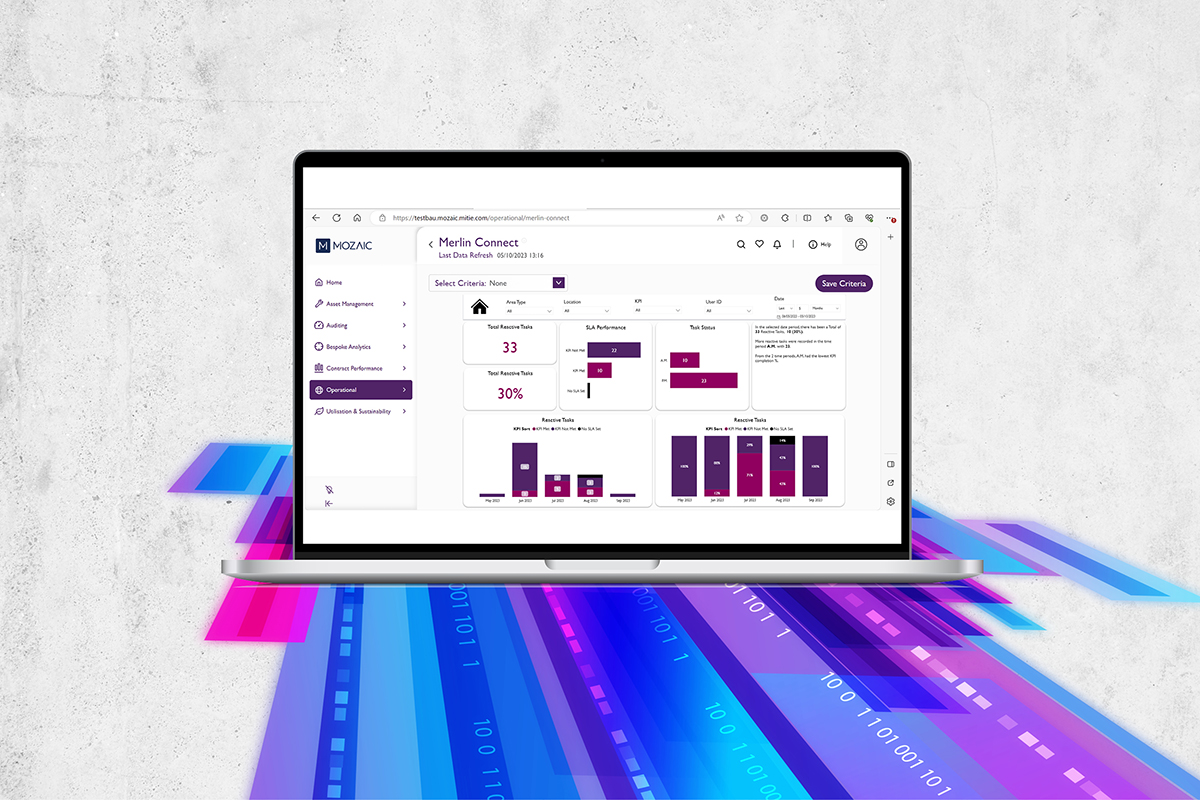
Use automation and robotics for cleaning excellence
By incorporating the latest in automation and robotics, alongside our highly-trained cleaning colleagues, we provide the ultimate mix of efficiency and service quality. We continue to explore, test and implement the latest innovations at our Cleaning & Hygiene Centre of Excellence, giving organisations in all sectors the assurance of spotless environments.
Learn more about our cleaning robots.
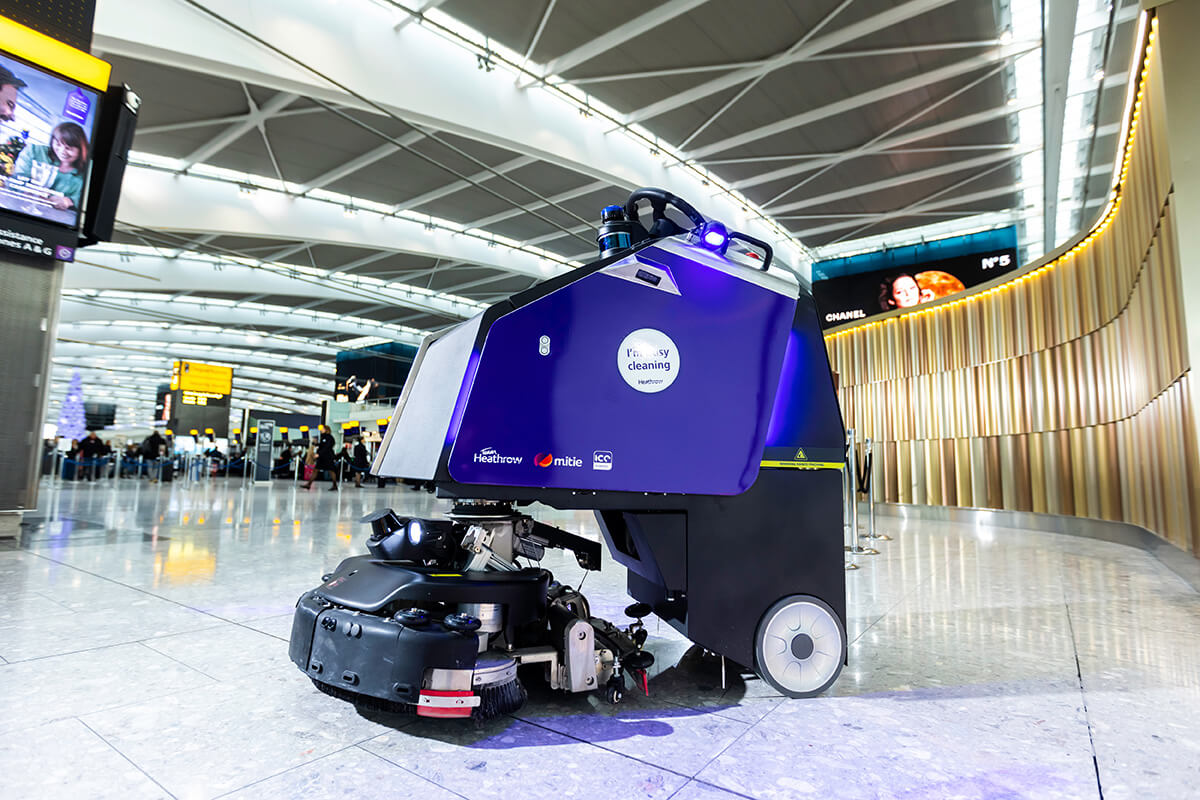
Reach your ESG targets with a sustainable partner
We can help you meet your challenging sustainability goals. Thanks to an industry-leading commitment to reach net zero carbon emissions by 2025, Mitie is well-placed to support customers on their sustainability journey. With a range of innovative solutions and specially-designed products throughout our cleaning services, we’re your go-to eco-friendly cleaning partner.
Learn more about our commitment to sustainability in our ESG report.
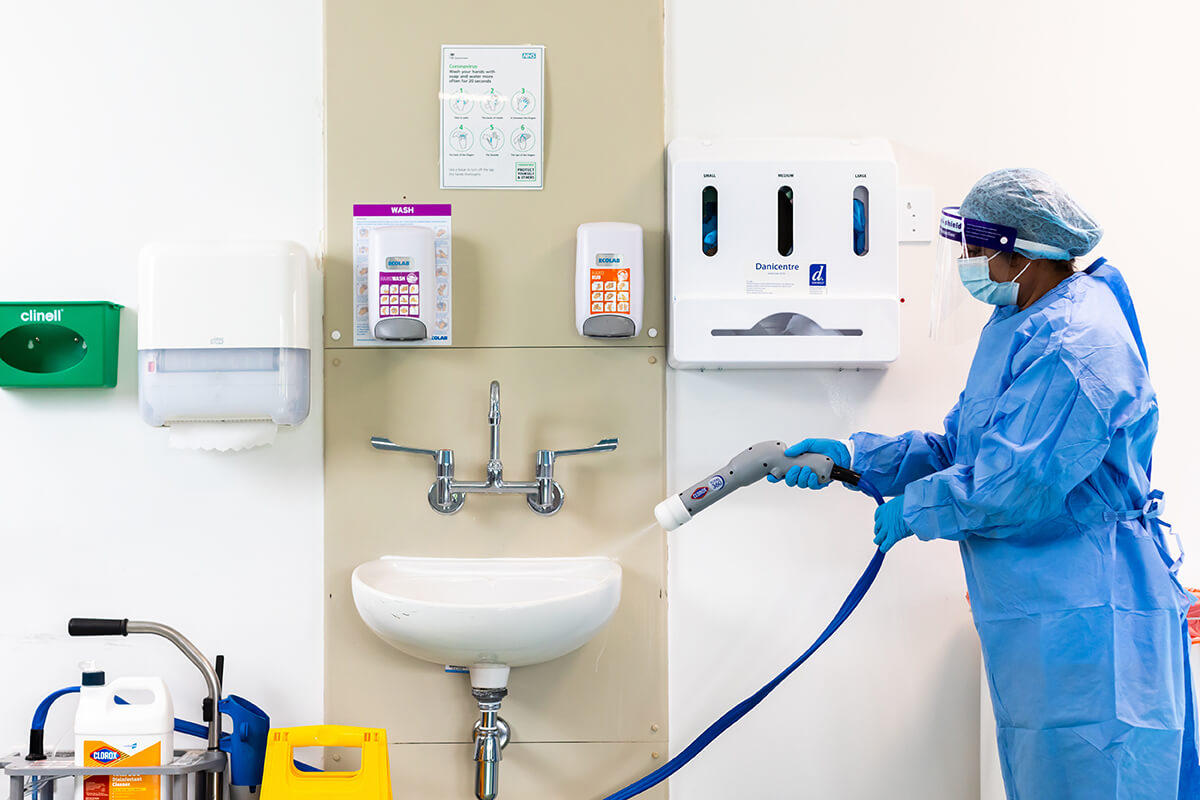
Highly-trained corporate cleaning professionals
People are at the heart of your organisation – and they’re at the heart of Mitie too. We continually invest in our cleaning colleagues and contractors. They benefit from the latest certifications, varied learning and development opportunities and, where appropriate, British Institute of Cleaning Science (BICSc) training. This means you have the assurance they are doing their best work for you.
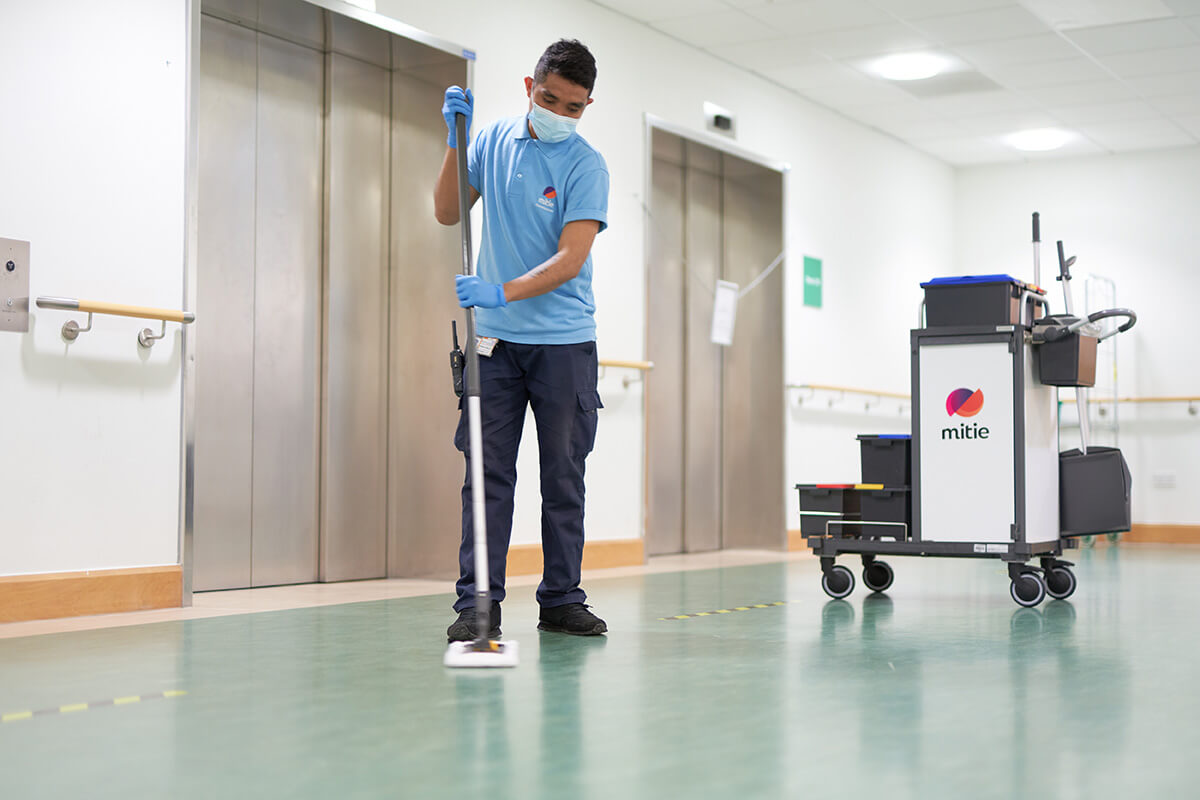
Create safe, clean, chemical-free environments
Ensuring the cleanliness of your environment and the safety of your people is our shared priority. We conduct deep cleaning with a range of natural, chemical-free products, which are robustly tested at our Cleaning & Hygiene Centre of Excellence. You can be sure your spaces are as safe as they are spotless.
Learn how the last few years changed cleaning forever.
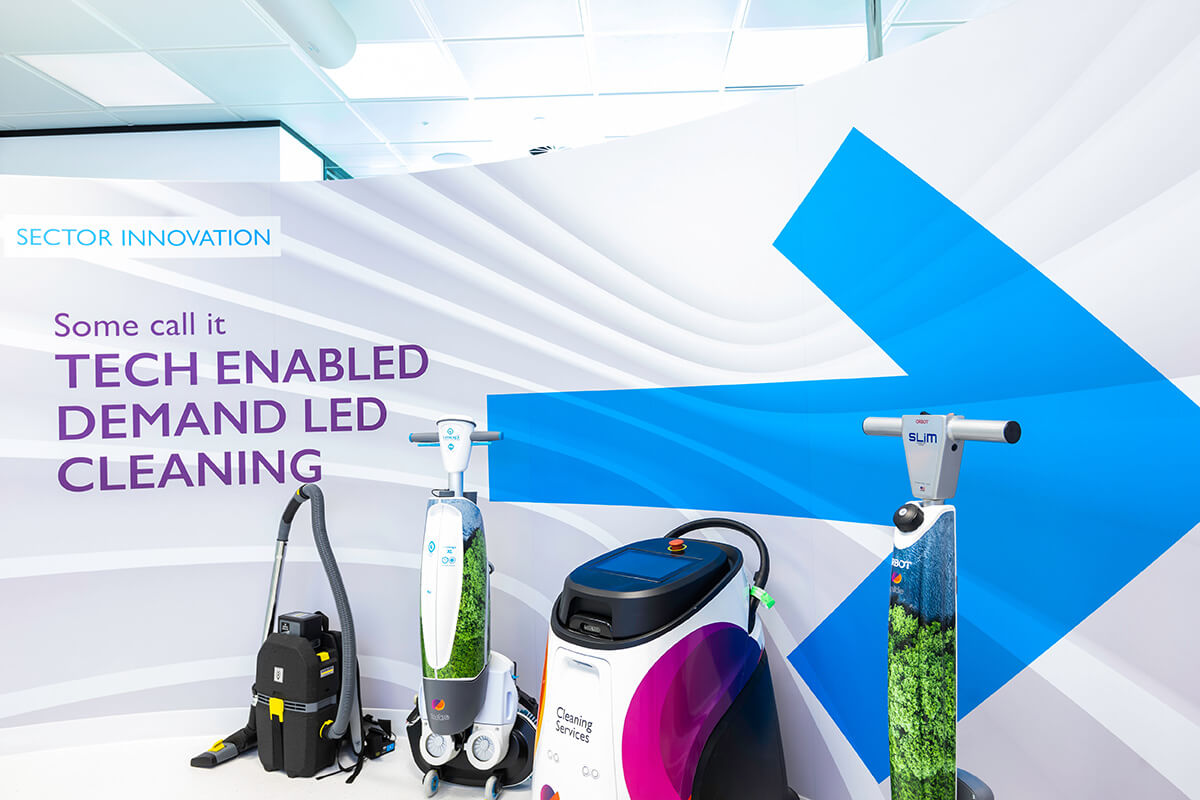
Clean any environment to enhance performance, perception and reputation
Your estate is unique, and your requirements are too. We offer the UK’s widest capability of self-delivered cleaning services, with vast experience in a range of environments including hospitals, kitchens, coldrooms, cleanrooms, laboratories, data centres and more.
Read all about our Cleaning and Hygiene services for different environments.
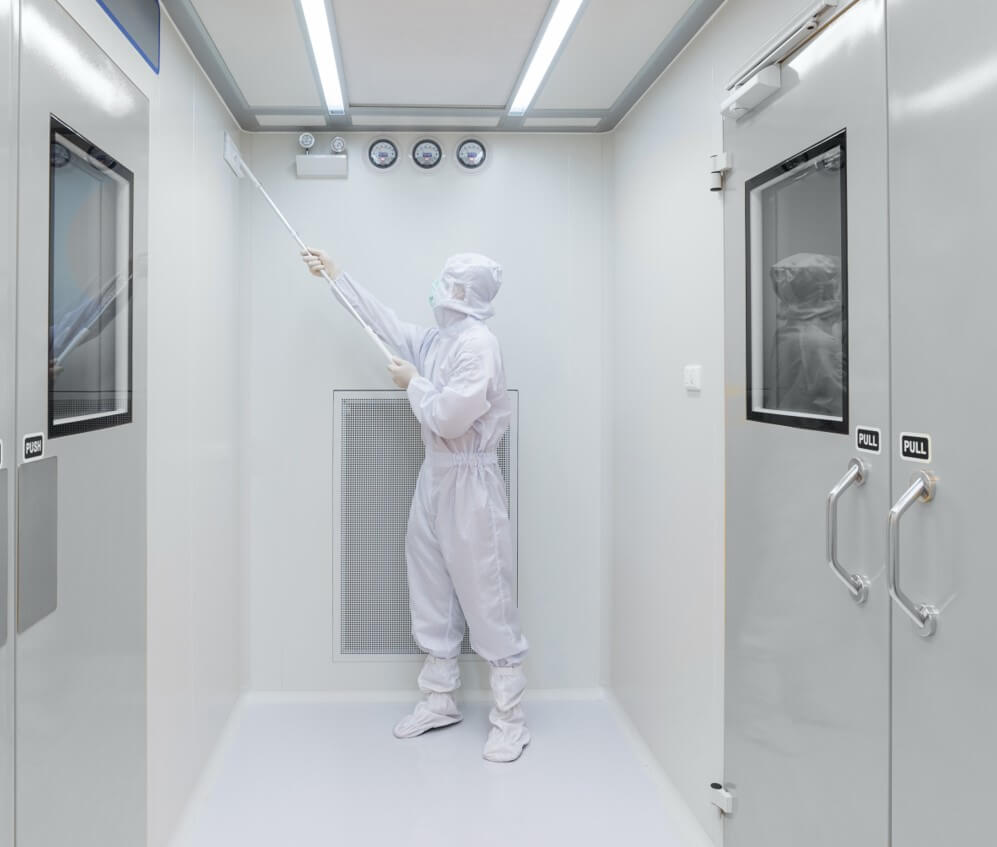
Our Cleaning & Hygiene Centre of Excellence
At our Centre of Excellence in Birmingham, we test the latest products, technologies and processes to further develop our commercial cleaning capabilities. Visitors are welcome to come and experience this unique facility, designed to bring the science of cleaning to life.
Explore our commercial cleaning services
We are proud to offer a range of professional cleaning service contracts across a variety of services and sectors, from high-rise window cleaning to commercial kitchen deep cleans.
17m
hours of cleaning delivered every year
25,000+
cleaning personnel across the UK
20,000,000
square feet of retail space cleaned every single day
3,000+
Covid deep-clean sanitations
Get an overview of our Cleaning and Hygiene services
A trusted cleaning partner in all sectors



Case studies & articles
- Case study
- 28 November 2024
- News
- 10 June 2024
- Podcasts
- 29 April 2024
- News
- 17 November 2023
- News
- 28 September 2023
- Insight
- 21 October 2022
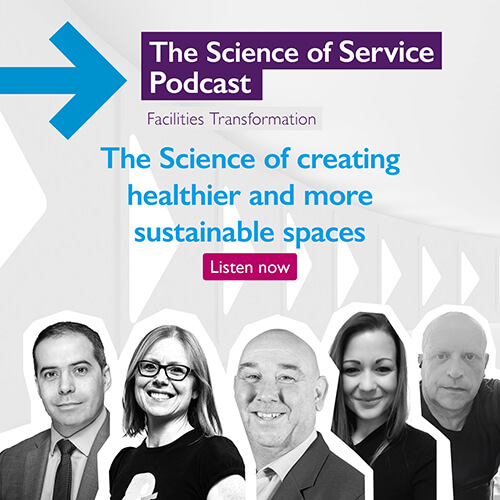
The Science of creating healthier and more sustainable spaces
Have you ever wished you had a robot to do the cleaning? For some, it isn’t just a pipe dream.
In this episode, Chris and Ian explore the leaps in technology that are driving innovation in hygiene. They visit John Radcliffe Hospital in Oxford to learn more. Thanks to the convergence of data analysis and technology like service ordering apps, patient experience is being transformed. Our hosts also discover the power of robotics in hygiene and patient care, as well as the rise in eco-friendly cleaning solutions. This revolution isn’t just enhancing efficiency, but also improving patient outcomes.
-
 Alice WoodwarkManaging Director, Mitie Communities
Alice WoodwarkManaging Director, Mitie Communities -
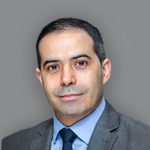 Jacinto JesusOperating Director, Healthcare, Mitie
Jacinto JesusOperating Director, Healthcare, Mitie -
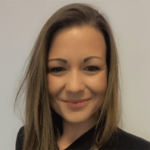 Heather DownesCleaning & Hygiene Centre of Excellence Manager, Mitie
Heather DownesCleaning & Hygiene Centre of Excellence Manager, Mitie -
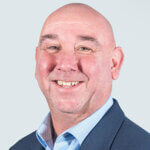 Andrew SharpAccount Director for John Radcliffe Hospital, Mitie
Andrew SharpAccount Director for John Radcliffe Hospital, Mitie -
 Derrick AndrewsHead of PFI, John Radcliffe Hospital
Derrick AndrewsHead of PFI, John Radcliffe Hospital
Have you ever wished you had a robot to do the cleaning? For some, it isn’t just a pipe dream.
In this episode, Chris and Ian explore the leaps in technology that are driving innovation in hygiene. They visit John Radcliffe Hospital in Oxford to learn more. Thanks to the convergence of data analysis and technology like service ordering apps, patient experience is being transformed. Our hosts also discover the power of robotics in hygiene and patient care, as well as the rise in eco-friendly cleaning solutions. This revolution isn’t just enhancing efficiency, but also improving patient outcomes.
-
 Alice WoodwarkManaging Director, Mitie Communities
Alice WoodwarkManaging Director, Mitie Communities -
 Jacinto JesusOperating Director, Healthcare, Mitie
Jacinto JesusOperating Director, Healthcare, Mitie -
 Heather DownesCleaning & Hygiene Centre of Excellence Manager, Mitie
Heather DownesCleaning & Hygiene Centre of Excellence Manager, Mitie -
 Andrew SharpAccount Director for John Radcliffe Hospital, Mitie
Andrew SharpAccount Director for John Radcliffe Hospital, Mitie -
 Derrick AndrewsHead of PFI, John Radcliffe Hospital
Derrick AndrewsHead of PFI, John Radcliffe Hospital
“The cleaning industry has never moved so quickly. Since the introduction of robotics, it’s allowed us to actually start moving forward with that smarter way of working.”
Heather Downes, Head of Innovation & Product Development, Cleaning & Hygiene Centre of Excellence, Mitie
Episode links
Mitie’s Cleaning and Hygiene Centre of Excellence
Mitie secures new £92.5m contract to support the John Radcliffe Hospital
Episode 5: The Science of creating healthier and more sustainable spaces
Speakers:
Chris Moriarty
Ian Ellison
Alice Woodwark
Jacinto Jesus
Heather Downes
Andrew Sharp
John Lear
Derrick Andrews
Robert Malpas
Ian Ellison: How much do we take our health for granted?
None of us want to be ill exactly, but how many of us are aware of the secret work around us to make sure that our healthcare environments, which need to be seriously clean, are being managed to the desired standard? Because it can mean a matter of life and death.
When you’re sat in an emergency department waiting room, are you even aware of the workforce, the tools, the products and processes that operate daily to make sure that when people are at their most vulnerable, there are no microbes or bacteria making things a whole lot worse?
And beyond the cleanliness of these environments, how is technology evolving to support clinical teams taking care of all the non-clinical tasks that distract from patient care, and collecting data to make informed decisions and maximise limited resources.
It’s not just clinical environments that have to take a forensic approach to health and hygiene. The pandemic highlighted how any environment where people come together needs to be mindful of the spread of germs. And so more companies are demanding increased levels of service than ever and are adapting brand new technologies, not only to reduce the spread of infections in workplaces, but to enhance the workplace experience.
And how do we balance these new products and technologies against the need to be more sustainable? Such as the impact on the environment of many of the chemicals deployed in the past. Today, we’re starting to see cutting edge science unfolding a new era in health and hygiene for all of us.
This is the story of these new technologies. This is the Science of Service.
Chris Moriarty: Hello and welcome to episode five of The Science of Service Podcast. I’m Chris Moriarty…
Ian Ellison: And I’m Ian Ellison.
Chris Moriarty: And welcome to today’s episode, which is exploring the hidden world under the surface. As we’re looking into the Science of Service in the world of health and hygiene.
Now, this is our fourth deep dive of the series following our original invitation by Mitie CEO, Phil Bentley, to get out and explore the Science of Service with Mitie clients and sector experts. Now, if you do want to go back and listen to previous episodes, now would be a good time to do it and we’ll wait for you here.
Right. Hope you enjoyed them. Now, today’s episode revolves around a hospital. John Radcliffe Hospital, part of the Oxford University Hospitals, but first, Ian, we need to set the scene, don’t we?
Ian Ellison: Indeed we do, Christopher. So this episode in some respects is the most important of all because the healthcare environment is one where I think you can make the case that facilities management cannot be positioned as a non-core service because it’s so integral to healthcare, hygiene, and the patient experience. And as we’re about to explore today, it can be directly linked to patient outcomes.
Now, obviously we don’t always choose to end up there, but most of us at some stage in our lives have had to go to hospital. Whether it’s the maternity wing welcoming in a new life, the A&E department because of a mishap, or for some elective surgery, these spaces are always on, always working and always need to be operating to a number of standards to make sure they remain healthy and hygienic environments for a very good reason.
And all of this, whilst the UK’s National Health Service, the NHS, is under extreme pressure through increased demand on their services and strains on their limited resources. Now, at this point in previous episodes, we often turn to an external expert, and we have one of those for you. Don’t fret, a proper cleaning boffin, by the way, but we’re going to save him for now. Because instead we’ve got an equally expert voice, someone who sits on the Mitie executive board and is called…
Alice Woodwark: Alice Woodwark, and I’m the Managing Director for Mitie Communities. So I look after Mitie’s work in local public sector.
Ian Ellison: and that includes hospitals like John Radcliffe. So, to start with, it might be worth us getting our bearings on how an organisation like Mitie supports a vast, multifaceted organisation like the NHS.
Alice Woodwark: When you have a health service that is really needs to transform, which is what we’re talking about at the moment, with the pressure that everybody is under, that’s the moment at which you need everyone firing on all of their cylinders. And the advantage of having a partner like us working in a healthcare setting, is that we are focused on specifically what we do. We are not expert in how you get a great oncology outcome. And, at the end of the day, that’s what our trusts should be focused on. So, it neatly allows expertise to be focused where expertise is going to be most effective. We know our world really well and we can deliver that hand in hand with partners who quite frankly have other things that they need to be focused on.
Chris Moriarty: Right. I’d much rather know that a clinician of some description that was focusing on making me well again, rather than some administrative task. It’s about getting the right expertise in place for the right job.
Ian Ellison: Yeah, but we all know from what we read and see in the news that the healthcare system is under enormous pressure, which has made that focus on the best use of resource even more critical.
Alice Woodwark: The pressures that the NHS are under at the moment, we’ve not, we’ve not seen the like of it. Um, certainly in my working lifetime. It’s a moment where we know we have to change some ways that we’re working. We know we also have to be the best version of us that we can possibly be to support a healthcare system that is under enormous amounts of challenge and that makes it a time actually when our work is more important than it’s ever been and the contribution that we can make to society and to the success of our clinical friends is more than it’s ever been.
The dominant themes in healthcare at the moment remain clinical outcomes, and also throughput. You need people to get through the system. There are all these stories about we need to get people flowing through a hospital. And we are everything in that environment other than the doctors and the nurses. So we create that flow.
These are people who really know that the way you’re treated as you go through this environment have massive outcomes on how you’re going to do and whether we’re going to see you back there again. So you need that combination of the human and the process, and that’s where the work that we do becomes really important. So that’s what my clinical colleagues talk to me about the whole time.
Chris Moriarty: That’s interesting. So what Alice is talking about is the entirety of the experience, the whole system. So clearly the health aspect of that is critical. You go to these environments to get well, but the experience you have in there, the speed in which you go through the various stages, whether that’s down for an X-ray or onto a ward, getting checked out. These are all critical, in a time of strained resources, to get right.
Ian Ellison: Indeed, and just to develop this thinking a bit, there was a book written in 2010 called ‘Transforming Healthcare’ by Charles Kenney. It was essentially a case study of a particular cancer care centre in the United States, the Virginia Mason Medical Centre, and the management there, headed up by this chap called Dr. Gary Kaplan, they were really struggling. The centre was failing and they ended up having to look beyond the healthcare sector to find a viable solution. This journey completely reframed their thinking about what is and what isn’t acceptable in a healthcare environment. And they basically learned that service efficiency, effectiveness, and patient experience are all interlinked.
Chris Moriarty: So we’re talking systemically then. Okay, so let’s catch up with someone who lives and breathes this every day. So let’s go to John Radcliffe Hospital and catch up with Mitie’s principal client there, called…
Derrick Andrews: My name is Derek Andrews. I am the PFI contract manager for the trust, for soft FM services, working out of John Radcliffe Hospital. So it’s Oxford University Hospitals Trust. And within that trust, there’s four main hospitals, um, three in the Oxford area.
John Radcliffe Hospital is the large, uh, accident emergency general hospital that most people will find in a city centre somewhere. Um, it, covers a diverse range of services, um, from both medical and surgical, as well as emergency services, trauma, children’s hospital, various things like that.
I think our biggest challenges in the hospital, particularly in, uh, John Radcliffe is, getting access to the areas, particularly in some very fast-moving environment, like a, an emergency department. It’s ensuring that patients have moved on time. And when they are moved, we can get in there to clean it, ready for the next patient.
What we’re trying to do is be as efficient as a service as possible because every efficiency that we make has a knock-on effect to the patient care in the end. Um, and so we try to lighten the load as much as possible from nursing staff, but in particular, so that they are able to do their core job.
Ian Ellison: That turnaround seems really important. It’s one thing getting a patient ready to go home, but they also have to turn beds around too, and that cleaning part sounds particularly important.
Chris Moriarty: It is. In fact, it’s not just about running a mop around. There’s a really specific set of standards that they have to meet.
Derrick Andrews: We in the NHS have national standards for cleanliness, that then translated into a trust policy that then gets inserted into the service level specifications with service provider. So, it may be, uh, it may be a television, it may be a bed, it may be a chair, it may be uh, heart monitoring or nurses equipment.
Ian Ellison: And each one of those have a standard.
Chris Moriarty: Yeah. And as you can imagine that all has to be documented and recorded. And that’s another task on top of the core activity itself.
Derrick Andrews: The main amount of monitoring in terms of cleanliness is done by the service provider. However, my team get involved in that as a check and balance to make sure that they are auditing to correct levels. We work very closely with all our service providers to ensure that they are auditing to the correct levels and auditing the right amounts every month.
Chris Moriarty: This is more than just a form on the back of the door saying someone has checked the area every hour. This is a very rigid, very clear set of standards of cleanliness that have to be met. It’s an industry of activity in and of itself. And earlier we were talking about scant resources. This all feels very labour intensive.
Ian Ellison: Well, Chris, there’s a new workforce on the way that’s transforming the way Mitie are approaching this.
Chris Moriarty: Do, do you mean..?
Ian Ellison: Oh, I do think so.
Chris Moriarty: You mean we’ve waited five episodes and I finally get to talk about…
Heather Downes: Since the introduction of robotics…
Chris Moriarty: Robots!
Ian Ellison: You got it.
Chris Moriarty: So who are we talking to now?
Heather Downes: I’m Heather Downes, Head of Innovation and Product Development, and I run the Centre of Excellence in our Birmingham office.
Ian Ellison: So Heather here leads Mitie’s innovation work around their cleaning solutions.
Heather Downes: The Centre of Excellence is, um, is a unique R&D facility where we’re not able to just showcase some of the most innovative solutions within cleaning, but actually give live demonstrations, review the efficiency and the productivity of those solutions that have been put out into the, uh, into the client’s environments as well.
The cleaning industry has never moved so quickly. You were lucky if you were able to get your hands on a ride-on scrubber dryer or a walk behind machine. And since the introduction of robotics, it’s allowed us to actually start moving forward with that smarter way of working, allowing the autonomous machines, or smarter machines, to do a lot of the harder, more time-consuming duties. Which then gives the cleaning operatives to focus on the need.
The majority of work within the cleaning teams is floors. So if we can remove that from the operatives front, give that to the robots, it then allows us to work on all of the high profile areas, touch points, frequencies can be improved, you’re elevating your cleaning service. So more frequency of cleaning within the washrooms, detailed cleaning, deep cleaning, periodic cleaning. For me, we always look at the cobotics very much in, you know, they’re working in collaboration with the cleaning teams, allowing us to then focus on those details.
Chris Moriarty: Cobotics. Sounds like something we’re going to hear a lot about in the future.
Ian Ellison: Isn’t it? So Chris, I know that since the moment we started this series, you wanted to see the robots. Well, guess what I’ve sorted for you? A visit to John Radcliffe Hospital where two of these robots have been installed by Mitie.
So you’re going to get to see them in action. But you’re not just there to see that, you’re also going to see how technology is transforming their service as well. what Alice and Derek were talking about earlier,
Chris Moriarty: Understood. So who am I looking for when I get there?
Ian Ellison: You need to ask for the Mitie lead, his name is…
Andrew Sharp: Andrew Sharp, Account Director for John Radcliffe.
Chris Moriarty: Lovely stuff. Right, well let’s go and have a look at it then. Um, and I guess this is the first thing you notice when you’re in a place like this is, there’s a lot of people, and I guess, obviously there’ll be quieter times, but it’s never off, right?
Andrew Sharp: No, it’s never off. It’s never off. It’s consistent all day.
Chris Moriarty: Do you know roughly what the sort of numbers are?
Andrew Sharp: I would say roughly around 5,000 people will walk through this hospital a day.
Chris Moriarty: A day?
Andrew Sharp: A day.
Chris Moriarty: And all going to different places, all…
Andrew Sharp: So multiple, you know, we’ve got three different, three different wings. Um, we’ve got, we’ve got a full maternity wing. We’ve got a main building block, uh, which sort of looks after all of operations from respiratory and things like that. And we’ve got the West Wing, which is the new PFI building was built about 20 years ago.
Um, that’s got all of the children’s wing and a heart and everything else that’s built into it.
Chris Moriarty: So shortly after arriving, I was introduced to…
Robert Malpas: I’m Robert Malpas, Portering Manager for John Radcliffe.
Chris Moriarty: Robert, another member of the Mitie team, has pioneered a new service in the wards. We called it the Portal Project, which is essentially a service ordering system for teams working on the wards themselves. Now that might be food, sample collection, bed cleaning after a patient has been discharged… but it’s another example of an improvement to the experience, an increase in efficiency, and it’s also a source of data for the overall work that goes on.
So he took me to the emergency department to take a look.
Robert Malpas: Right at the beginning when Mitie first took over this contract, we didn’t have a massive amount of data to go through. So we met with the matrons for the area, like the senior staff, asking them what they want to see on it. So they give us a list of tasks that most frequently booked, but then within a couple of months, you notice there’s certain things that weren’t being booked. So we took it off and then we’ve added certain bits.
Andrew Sharp: You know, we come in with technology and they’re like, “don’t really want that. Don’t really want that. We don’t know how to use that”. Um, but, you know, you’ve got to get people to buy into that process. Once they’ve bought into it, they could see, the benefits down the road of how they were going to use it, uh, where we’ve got people in radiology, we’ve got a static, but we also got people with mobile tablets that are walking around. They’re booking people in as they’re moving. They’re booking people as they’re moving out. They’re booking people.
So they reckon that the footfall has gone up by sort of, three or four times, just from them having the ability to be able to walk, book, walk, book, people coming in, people going out.
Chris Moriarty: Right. Wow, so you’ve seen it in the performances. So, yeah. Well, let’s go and take a look.
So it’s probably just worth pausing there for a second. What Andrew is saying is that this app that Mitie have built is allowing medical teams in the ward to book Porter services. So when we say Porter, we essentially mean the people in the hospital environment that move patients, equipment, and medical supplies around the building.
According to NHS careers, these folks are the heartbeat of NHS hospitals. And here we are with a tool that means that there is less wasted time in the process, which means that they can get more patients seen too.
Ian Ellison: And this focus on efficiency, effectiveness, and experience doesn’t sound dissimilar to our transforming healthcare case study that we talked about earlier.
Chris Moriarty: It’s almost like Lean Six Sigma for hospitals. Anyway, Robert shows me one of the portals and it looks like any other tablet you might have seen with loads of apps on it for each of the different services that this particular unit requires.
Robert Malpas: Yeah, so that’s what I was saying a second ago about, like, the tabs on it. So these are like the most frequently booked jobs for the area. You’ve got the full ad hoc catering menu on there. You’ve got discharge cleans, terminal cleans, and then portering tasks. So your patients in and out, like specimens, anything like that. You just click the button. They’ve got a specimen that needs to go to the labs – it’s booked it in a second. That’s now a live job on our system.
Chris Moriarty: Right.
Robert Malpas: Once a porter gets assigned to it, you can see that. But you’ll be able to see a porter is on his way.
Chris Moriarty: Right.
Robert Malpas: To do the job for you.
Chris Moriarty: Gotcha. Yeah. So, I mean, that looks just like all the different things… like, you know, like this sort of tile setup. It’s dead easy.
Robert Malpas: It’s simplicity at it’s finest. Yeah.
Chris Moriarty: So this is, so if you take through the process, and uh, someone’s talking to a patient said, “Can I get you some lunch? What do you fancy? Right, yeah, no bother”. And either they’ve got it on their, on the tablet, like you mentioned, or they can come here and just order one. And then that will then appear almost like a, these delivery services we’re used to. “Which bed do you want it to go to? That’s them over there”.
Robert Malpas: Yeah, so you just literally put the patient’s name and the bed number, it becomes a live task.
Chris Moriarty: Oh, so then, like, for something like that then, when it’s to a patient…
Robert Malpas: Yeah, we will take a name, for audit purposes…
Chris Moriarty: Ah, gotcha.
Robert Malpas: And the bed number.
Chris Moriarty: Oh, cool.
So whilst we were recording, one of the nursing team actually came across to tell us how amazing this was. Completely unprompted, she just saw us recording, and wanted to tell us that…
Diane: This is the best thing. Since they’ve come, it’s absolutely brilliant.
Chris Moriarty: So, you’ve worked here a while then, have you?
Diane: I’ve been in the Trust twenty-eight years.
Chris Moriarty: Twenty-eight. Okay, that is a while, that qualifies as a while.
Diane: On the wards, almost ten years down here.
Chris Moriarty: Right, and doing this sort of role, okay, and how, what difference does something like this make, in real terms?
Diane: A big difference. It helps the flow from ED onto us a lot quicker, because we’re able to order the beds discharged a lot quicker, so it makes a massive difference.
Chris Moriarty: And I guess there’s a lot of, a lot of, um, in the past when everything was very manual, a lot of lost time.
Diane: It was, yeah.
Chris Moriarty: Something doesn’t turn up, you can’t track it, you don’t know if someone’s, you know, with all of this, it’s kind of all been tracked at every stage, right? Yeah,
Diane: Looking for the domestics, we don’t have to anymore. We just literally go there, book the discharge, they’re, they’re on the job.
Chris Moriarty: Wow.
Andrew Sharp: So again, all the domestic staff, um, carry their PDAs on them. As soon as Diane hits that discharge clean or whatever it may be, the domestic knows exactly where it is, what bed it is, and they’re straight there to clean it and clean it out.
Chris Moriarty: So this is when a patient’s left, and you’ve got to turn it over, basically.
Andrew Sharp: So it’s called the patient pathway. You know, the patient pathway, Diane’s saying, from ED all the way through to the systems before they get up to a ward.
Chris Moriarty: And without getting too kind of into the biggest picture, that’s going to be, because like ED departments in particular, I’ve been to one recently, right, you know, where I live and there’s a lot of demand. Like the, you know, struggling. And I guess it’s helping with that as well, which is, is, you know, you’re, you’re the worst, you know, it’s bad enough not having a bed, but imagine having a bed that hasn’t been cleaned yet and someone’s got to wait. What we’re doing is we’re minimising that time for the patient experience as well.
Diane: Yeah, exactly.
Robert Malpas: So we’ve done a little bit of a trend at the beginning and on average to book a, any task, it was like two and a half to three minutes to call the help desk. You’d have to wait for them to answer the phone, take all your details, but this is, you’re talking seconds. Yeah. So we’re giving a lot of time back to the clinical staff.
Chris Moriarty: And I guess you sort of said about from an audit purpose, from a contract point of view, you’re also tracking that performance, right? Because I guess a job is open, so that’s still saying ‘specimen’, you know, we can still see that job’s there until someone comes down and closes it, i.e. that’s been picked up now. And you can start to look at response times, turnover, all that sort of stuff.
Andrew Sharp: Correct, correct, correct.
Robert Malpas: So what you can see now is a porter has actually been assigned to it.
Chris Moriarty: Yeah. It’s going to come down and we’re going to, “Oh, we’re just doing a podcast. Sorry about that”. Yeah.
Andrew Sharp: From a contractual point of view, you know, there’s the contractual point is, is huge. There’s, there’s so many KPIs that are attached to this contract. There was also so much data that’s not been captured in the Trust prior to us arriving where it’s been a lot of pen and paper where now they can see it real time. We do a report every month and they can see it digitally. They have a dashboard that they can go to.
Ian Ellison: Wow.
Chris Moriarty: I know, right? We get to see some cool tech and workplaces that make things a little easier, perhaps a little more pleasant, but this is probably the starkest example of where technology is making a demonstrable difference. Tangible and important difference. It was sort of inspiring talking to people in the ward about the difference this is making in a part of the hospital that if you’re unfortunate enough to need, you really want firing on all cylinders.
Ian Ellison: We often talk about workplace experience when we’re chatting about offices and the like, but here it’s as much about patient and visitor experience and how all of these little improvements are linked directly to health outcomes. It goes back to my point about how core these services are in a healthcare environment. They’re set up to remove waste, improve experience, and ultimately free up the medical teams to shine, which is something we all want.
Anyway, I know I warned you about getting distracted by robots. But you did actually go and see them, didn’t you?
Chris Moriarty: You mean Superman and Minnie Mouse?
Ian Ellison: What?
Andrew Sharp: We branded them because we use them in a children’s hospital.
Chris Moriarty: Oh, wow. Okay.
Andrew Sharp: So it’s there for a bit of a theatrical sort of scenery part for the kids to think, you know, while they’re coming into hospital. To see Superman rolling up and down or Minnie Mouse rolling up and down. It eases the pressure. So there you go. There’s Superman. Doing his thing.
Chris Moriarty: There he is.
Andrew Sharp: So you’ll see how much, uh, how many people pass comment as they walk past. You saw this little lad, he’s still looking at him. You know. Ha ha ha. So it’s, uh, and it says autonomous cleaning in progress so it tells you there’s a robot around. Yeah. Um. It’ll navigate around, um, and it’ll start to talk to you. It’ll come over this side now.
Chris Moriarty: Tell you to move.
Andrew Sharp: So, it’ll tell us to move. You have to map these out. Um, so they’re physically mapped and we map it out ourselves. So we have to clear the area. Then we wheel it to a certain point, press the button and it will recognise GPS. And once it’s mapped, you can pretty much leave it to do itself.
Chris Moriarty: What they do each night is kind of mapped out.
Andrew Sharp: Yes, yes.
Chris Moriarty: I guess it’s like each, do they do every corridor every night? Or is it..?
Andrew Sharp: They do certain corridors every night. So they won’t be able to do every single corridor, which is the amount of corridors that we’ve got. But, um, it will be on certain levels during the day.
Chris Moriarty: So that’s, that’s just, it spotted me and it’s, what, given a sort of six, six-inch birth, foot berth around me, got on with it and it’ll, I take it it’ll remember that now.
Andrew Sharp: Correct.
Chris Moriarty: And be like, right, I need to nip back and do it where those, those two idiots with the microphone were.
Andrew Sharp: So, so it shows like, on the, um, on the email printout that you get, it highlights in a light green pattern. On the map. So it’ll give you the map of this. Look at the map…
Chris Moriarty: Then it’s sort of showing you all the bits.
Andrew Sharp: It’ll show you where it’s gone and you’ll see where it’s zigzagged across again, where it’s obviously something that’s come in its way and it’s come back and re-cleaned that area.
Chris Moriarty: And would there ever be a situation where maybe it said that “I couldn’t clean that last night” and that will, that will instruct like a, an operative on the, on the shift to go up, or is it generally…
Andrew Sharp: It’ll generally do everything it’s put down do. But it could be, it could be a fault in the charge or something. Somebody’s put it out and not realised it’s not fully charged.
Chris Moriarty: Right. Gotcha.
Andrew Sharp: That doesn’t happen very often. It doesn’t happen at all. But you know, we fill out the water and it does, it does its work.
Chris Moriarty: And what difference has that made? To things like rotas…
Andrew Sharp: So it’s not about labour saving. It’s just about making sure that the job’s being done efficiently. Which allows us to concentrate on the corners and edges to make sure the place is absolutely spotlessly clean, 100 percent, not just somebody walking around with a mop.
Chris Moriarty: Yeah. Yeah.
Andrew Sharp: Which we do have in areas. On these large corridors you’ll have somebody here for many hours, just walking up and down. You want to, you want to pre, uh, work the floor first. You want to sweep it and make sure the debris off it before the robot can start.
Chris Moriarty: And how was it when, you know, you’ve got a cleaning workforce, right? And one day you’ve come down to them and said, “right guys, we’ve got these”. What was, you know, what was that kind of initial reaction like?
Andrew Sharp: The initial reaction was quite, quite receptive actually. Yeah. You know, it’s not about, we’ve always made the plea that it’s not about removing labour. It’s about making sure the detailed part of the clean is being done properly.
Chris Moriarty: Yeah, yeah.
Andrew Sharp: It’s not just in there to do a quick slap and dash and get out the door. It’s about the robot doing its work and that’s about doing the corners and edges and that’s one…
Chris Moriarty: And was that, I mean you’ve mentioned that at a couple of times, corners and edges, was that historically a challenge?
Andrew Sharp: Very much so, very much so. I mean, a robot doesn’t do corners and edges. Uh, it’ll only do a floor base, the way you set it out to clean. But where all the, the bits behind the doors, the bits behind the, the chairs. It’s where we need to clean. Just to make sure the clean is being done a hundred percent.
Chris Moriarty: Yeah. But before you had the robot, I mean, I, I guess what that meant is that your guys are having to do the big space and the corners and edges, and then there’s always a risk of… missing stuff. I’m not saying you did miss stuff, but there’s a risk of that. It introduced a risk to it. Whereas if all they’re doing is the corners and edges, it’s much more focused, right?
Andrew Sharp: You’re not missing anything.
Chris Moriarty: And again, you’ve got an audit trail, so you’re saying about your reports in the mornings…
Andrew Sharp: Correct, correct. We’ve got audit trails that we can prove, you know, how much water it’s saved us. What time it’s taken out of our workforce, but you know, if you think from the front door all the way down there to that, those doors down there, you know, it’s about a quarter of a mile.
Chris Moriarty: Yeah.
Andrew Sharp: That’s a quarter of a mile that somebody’s got to stand and walk up and down and clean.
Chris Moriarty: So there you go, Ian. What do you make of that?
Ian Ellison: Yeah, it’s pretty impressive actually. So having listened to that, I thought I’d have a catch up with…
Jacinto Jesus: Jacinto Jesus, and I’m the Operations Director for Healthcare.
Ian Ellison: …Who has responsibility for a number of these healthcare contracts at Mitie to really understand the impact it’s having from his point of view.
Jacinto Jesus: This technology has really enabled us from going from, um, what we call predictive, um, uh, cleaning, um, or predictive portering, to being demand led.
The information wasn’t available in real time that we can make those critical decisions, and now that information is available to us so we can actually make those decisions. In any workflow, you’ve got bottlenecks. So you want to try and remove as many as possible and make it as smooth and as efficient as possible. And that demand led data, or that technologies, is really allowing us to do that because we are making it more efficient. We are saving time.
Um, some of our systems, which is actually really interesting, is actually um, promoting wellbeing for our staff. Because it’s invisible, you know, you know, it’s… patients and staff and visitors walk through the hospital, they don’t see any of this. Um, but, and that’s the beauty of it because we want to do things without… most times without people noticing, without disturbing them.
Chris Moriarty: And did you ask him about robots? You had to have asked him about robots.
Ian Ellison: Yeah, of course I did.
Jacinto Jesus: I think that we are at a very early stage of the introduction of robots into the cleaning service, and even into the other services. So, for example, the robots that we have a John Radcliffe, they are just fantastic because they go on and do the work that they do, um, while our staff can focus on, you know, critical touch points whilst the robots are cleaning the floors
But for us, for the cleaning environment is fundamental and critical to have more of these machines around. Um, the water saving is just incredible. The machines we use has got a four-stage filter built into the machines and it saves 70 percent of water in comparison to a traditional scrubber dryer.
John Radcliffe is a great case study for this, is that we want to move away from facilities management to transforming facilities.
Chris Moriarty: I’ve heard that before…
Ian Ellison: You have. This all really connects with the central theme throughout this series about technology and data better supporting human expertise. And along the way, making us more efficient and able to add more value to the environments we’re talking about. This is exactly what Phil Bentley was talking about in episode one.
Chris Moriarty: Science and service facilities transformation. So we’ve talked a load about the service in this episode, but it’s probably about time to get knee deep in the science.
Ian Ellison: Right. Alice can lead us into that.
Alice Woodwark: I really think that the advent of robotic and technology led cleaning is going to do for hygiene, for our industry, what the microscope did for doctors.
I mean, if you think about it, before they had that microscope, they thought they were doing the right thing. They hoped for some good outcomes. Once they could see the impact of what they were doing, they knew that they were doing the right thing. And for us using this technology, the robots show us exactly where they’ve gone and they record the data that tells us how effectively they’ve cleaned.
And for the first time, cleaning has genuinely become a science. We can show you how clean something is. If you come to our Centre of Excellence, we can show you all of the UV technology that will quite scarily tell you exactly how clean any surface, any set of hands is. And we’ve never had that before.
And so actually, it completely revolutionises the way you think about cleaning. Because rather than doing a rote set of things, and hoping for the right outcomes, because a lot of clean can’t be seen, and we know that, we’re now in a place where we can show you and prove to you the effectiveness of the tasks.
And of course that means we can do that more efficiently, more effectively. I think that’s going to fundamentally change the way that cleaning works.
Chris Moriarty: That’s really powerful. So is that the same as the Centre of Excellence that Heather was talking about earlier on?
Ian Ellison: One and the same.
Heather Downes: I think from a testing point of view, whilst the technology has been available and would have been used within certain environments, such as healthcare or food, where the demand was there, we wanted to be able to provide the other sectors, such as corporate and professional, those opportunities to see and feel assured by that level of cleaning that was being done.
So it’s, again, it’s just elevating that service. Some of it isn’t new technology, some of it is old tech that we’ve just adapted and we’ve started to introduce. You know, ATP testing has been around for a really long time but there was never really a call to action to understand the bacteria that was on the surface.
Ian Ellison: ATP testing?
Chris Moriarty: Yeah, I didn’t know either, but I looked confident and nodded, but afterwards I was able to catch up with…
John Lear: My name is John Lear. I’m one of the Technical Directors at Biological Preparations Limited. I’m the Director of Microbiology and Research and Development.
We are a biotech company specialising in the, the use of biology, across a number of industries really. As far as cleaning goes, we offer biohygiene, which is our range of, uh, sustainable and environmentally friendly cleaning products. And really in terms of Mitie, so Mitie have been a customer of ours for a while.
And for the last two years, well a little more than two years really, I’ve been providing really sort of scientific and technical support to Mitie, uh, and assisting them in that way really.
ATP testing is quite a useful little method as long as you understand the sort of the limits really, and it’s, it’s a measure of organic soiling on a surface. So you, you can use, uh, use ATP testing like, like I do, when, when I come to Mitie in order to, to check the efficacy of your cleaning processes.
Heather Downes: Through the pandemic, people needed that assurance because they weren’t coming into the workplace, and to give our clients assurance that their workplaces were safe enough for people to return. This was a measure that we looked to introduce.
We’ve had to start looking at the science behind the chemicals that we’re using because of the detrimental impact that they have, not only on the users, the people in those environments, but ultimately the planet. That we’re referring to plant based solutions, water based solutions, that are still achieving the same results, if not better, because of that environment. And really, that’s the first thing that kind of comes to my mind is when we’re looking at science is we’re really scrutinising even down to what we’re spraying on surfaces. Is this the right solution? Is it still receiving the same results as what we were doing before or better?
Ian Ellison: Wait, what? Are we talking about natural cleaners here?
Chris Moriarty: Yeah… so John talked me through what his company does other than explaining ATP to people like us. And it involves using good bacteria to combat bad bacteria. So earlier when Heather mentioned how this technology has been around for a long time, she really wasn’t kidding.
John Lear: Bacteria were among the earliest, most primitive, uh, organisms on the planet. So the technology has already always been there. They have been there doing their thing since the dawn of time, but our understanding of that and how to harness it has not come really until the sort of latter half of the century and, and really sort of, intensely into the sort of latter quarter.
Basically, we make products containing bacteria, enzymes, plant extracts, uh, other environmentally friendly and sustainable solutions, and biohygiene really has taken that a step further. Bacteria and other microbes, uh, break down organic matter in their, in their immediate environment. And that’s how they sustain themselves, if you like that sort of thing. That’s how they, that’s how they nourish themselves. That’s what they do.
I mean, indeed, if they didn’t do that, then we’d all be like neck deep in our own waste by now. Uh, and that is a process that happens, of course, quite naturally in the environment, but we can harness that. We can take control of that, by incorporating bacteria and other microbes into cleaning products.
So, uh, specifically, if you like, so if we take a washroom cleaner, for example, then that, that formulation will contain bacteria, contain beneficial bacteria. When we use that product in, uh, at the site of application, in the washroom, to clean, those bacteria will proliferate, proliferate, they will grow, they will form a beneficial population.
And, uh, what they like to do specifically is to grow in films called biofilms on surfaces. And, so they will do this, they will form biofilms on surfaces and they will degrade organic matter in their immediate environment. And by doing that, then, they provide a long-term cleaning effect and one of odor reduction because they’re breaking down the organic matter that causes soiling and that causes unpleasant odors.
Ian Ellison: So what with enzyme powered cleaners, robots, service ordering apps, and data everywhere, the whole face of health and hygiene could be about to be revolutionised. I put that to Alice, about what she makes of it all and what it means for the future.
Alice Woodwark: We need the best of the technology that we can get our hands on. Both to make us as effective as possible, but also tell us things that we might not be aware of by doing things, I guess, in a more traditional way. Data can tell you things about how well you’re doing your job, how well your patients are doing in a clinical environment, and then if you look at the service side, that’s what brings it to life.
I love a robot, but it’s never going to always be about the robot. We know, and it’s proven, that if you have great service in a clinical environment, people’s recovery times are faster, people’s experiences are better, they will get better quicker. And so there is this human side to it that is always going to be integral to what we do. We are often the first and the last person that a patient will see in, for example, a hospital setting. So having the human wrap around a really strong technology core, I think is fundamental to what we do, both in terms of clinical outcomes, but also in terms of the productivity, the effectiveness of our work.
So if you take something like technology that will allow us to identify and then report how much of a meal a patient has eaten, then that is important for all sorts of things. Clinically, that’s great because you know things about their nutritional balance that you might not otherwise know. It’s going to be someone like us that’s doing that data collection. That’s effectively a non-clinical task, but it feeds right into your clinical outcomes. And it also allows us to manage the efficiency of feeding people in hospitals. At the end of the day, we need every penny that’s going into the hospital system to be as effectively spent as possible. We all do as citizens.
And so if we can find ways of making something like patient feeding more efficient and effective, because we know where the food needs to go, where the food’s being consumed, then that will also help us as well. So I would say that actually the way that data and technology works is very much interlinked and hand in hand between our clinical partners and us as the supporting cast that works around them.
Chris Moriarty: What a lovely way to end the episode. And like we said, our last deep dive into the Science of Service and what an adventure it has been. We’ve looked at climate, security, workplace experience, and now health and hygiene. We’ve seen robots, data, newfangled technology. But we’ve always seen that paired with human endeavour, creativity, and expertise. This truly is the Science of Service transforming facilities as we know it. I’m really going to miss our little adventures.
Ian Ellison: Well, don’t get too emotional yet, Chris. We’ve got one more episode for you lovely folks. Next time out, we’ll be heading back to The Shard to speak to the members of the Mitie leadership team that we spoke to in episode one, and some new voices, to reflect on the journey that CEO Phil Bentley originally sent us on.
Chris Moriarty: Speak to you then.
We are really pleased to be working with Mitie, particularly in respect of their use of eco-friendly products and sustainability credentials. It is important that all our sites maintain excellent standards so they are comfortable, safe places for our workforce and any visitors.
Darren Richards, Head of ICT and Estates, Cleveland Fire Brigade
Commercial cleaning awards and accreditations
Our cleaning and hygiene work is achieving significant recognition.
Cleaning Operative of the Year, 2024 Cleaning Excellence Awards: Juan Carlos Orrego at Deloitte
Manchester Airport, Platinum Plus rating, 2024 Loo of the Year Awards
Washroom Cleaner of the Year, 2023 Loo of the Year Awards
Sustainable Company of the Year, 2021 Cleaning Excellence Awards
Cleaning Operative of the Year – Osman Abdi, 2021 Cleaning Excellence Awards
RoSPA Gold – Royal Society for the Prevention of Accidents
Outstanding Security Performance Awards
Fire and Security Matters Awards
CIPS Procurement Excellence Award
Edie Sustainability Leaders Awards
Outstanding Achievement Award, Green Fleet Awards
Safe Contractor approved
Contractors’ Health and Safety Assessment Scheme accredited
Disability Confident accreditation
ISO accreditations including 9001, 14001 & 18001
Meet the team supporting commercial cleaning
Get in touch about cleaning services
If you want to talk to one of our Cleaning and Hygiene experts about your business’s cleaning service needs, they’re just a couple of clicks away. Fill out the form, and we’ll be in touch.
 Skip to content
Skip to content




